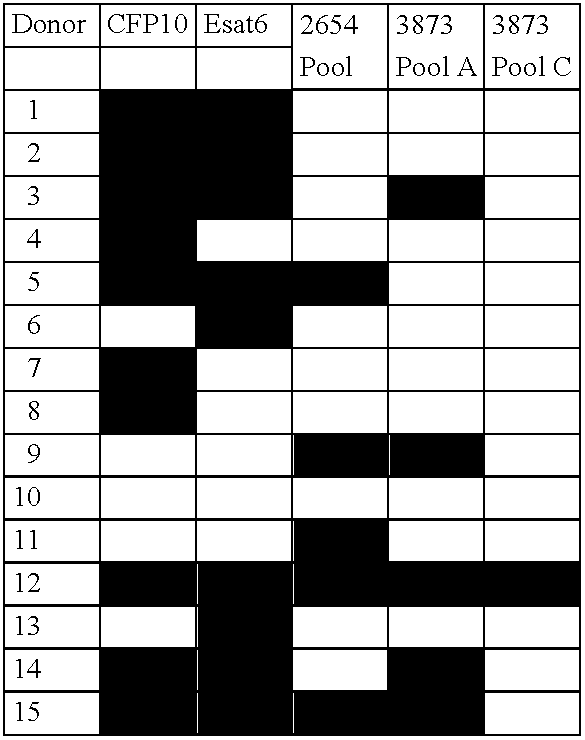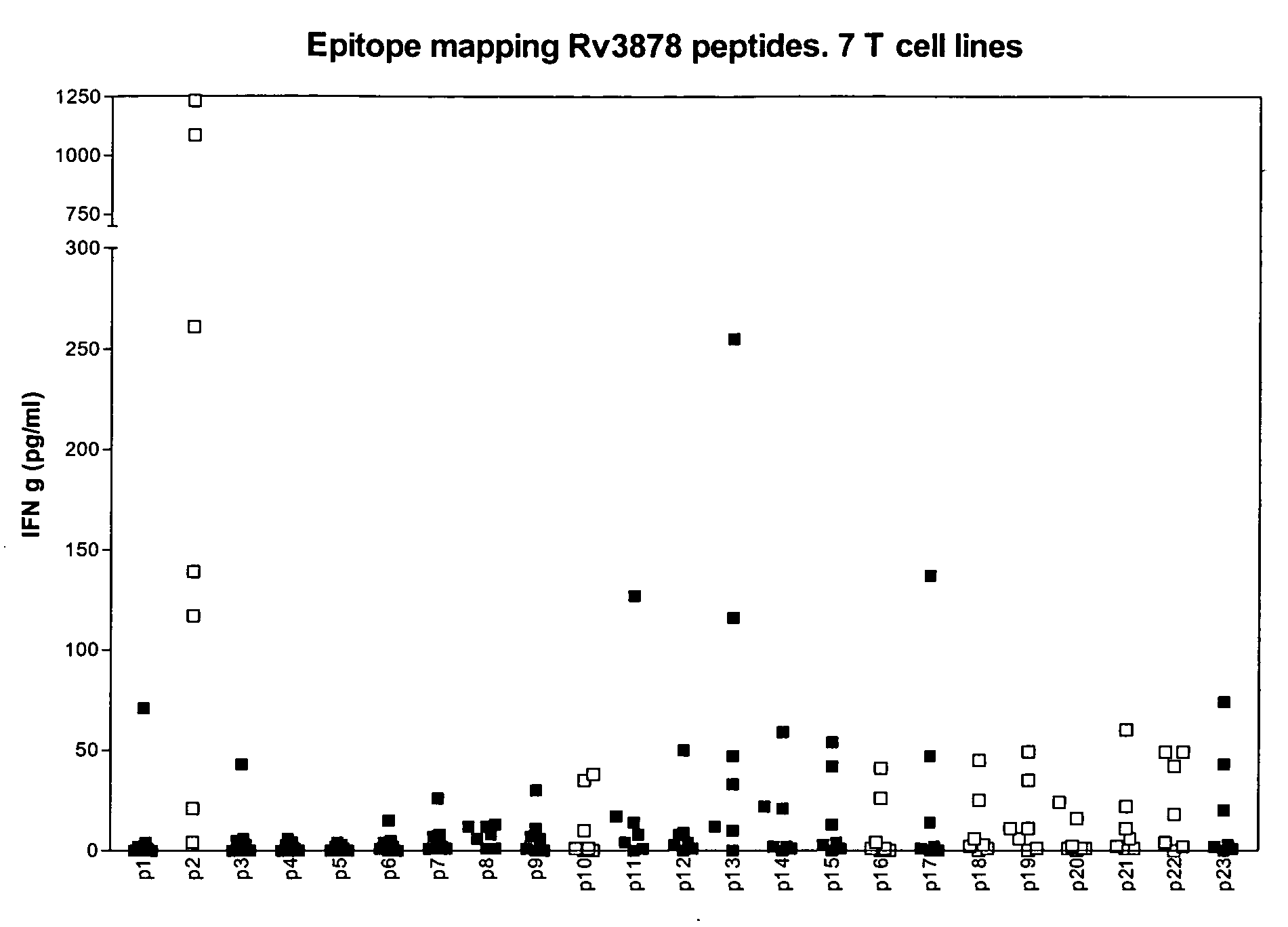Specific epitope based immunological diagnosis of tuberculosis
a tuberculosis and immunological diagnosis technology, applied in the field of specific epitope based immunological diagnosis of tuberculosis, can solve the problems of increasing risk, reducing detection accuracy, and reducing detection accuracy, so as to improve detection accuracy and broaden the recognition
- Summary
- Abstract
- Description
- Claims
- Application Information
AI Technical Summary
Benefits of technology
Problems solved by technology
Method used
Image
Examples
example 1
Assay Conditions
[0097] PBMC were obtained from healthy BCG vaccinated donors with no history of contact to M. tuberculosis and from TB patients with microscopy- or culture-proven infection. Blood samples were drawn from TB patients 0-6 months after diagnosis. PBMC were freshly isolated by gradient centrifugation of heparinized blood on Lymphoprep (Nycomed, Oslo, Norway) and stored in liquid nitrogen until use. The cells were resuspended in complete RPMI 1640 medium (Gibco BRL, Life Technologies) supplemented with 1% penicillin / streptomycin (Gibco BRL, Life Technologies), 1% non-essential-amino acids (FLOW, ICN Biomedicals, CA, USA), and 10% heat-inactivated normal human AB serum (NHS). The viability and number of the cells were determined by Nigrosin staining.
[0098] PBMC cell cultures were established in triplicates with 1.25×105 PBMCs in 100 μl in microtitre plates (Nunc, Roskilde, Denmark) and stimulated with 5 μg / ml PPD, peptide pools spanning the entire length of the four prot...
example 2
Selection of Immunogenic Antigens
[0102] We have screened a large proportion (more than 70) of the ORF's deleted from BCG and only a few (approximately 10) of them are immunoreactive. The ORF's were tested for immunoreactivity using either isolated PBMC from TB patients or using T-cell lines derived from TB patients.
[0103] In table 1 the results from 10 deleted ORF's are shown. These results illustrates the fact that not all RD proteins are immunoreactive when tested with sensitised lymphocytes, and none of these 10 example antigens is recognised by the T-cells.
TABLE 1Table 1. Examples of antigens belonging to the RD regions tested inT-cell lines derived from TB patients. Results are giving in pg / ml IFNgamma. Positive results are marked with bold.RD regionAntigenLine 1Line 2Line 3Line 4Line 5Non61140PHA33131750203323881127RD4Rv 0221310597RD4Rv 022316145RD10Rv 1256022911RD3Rv 1574202390RD3Rv 15802650220RD15Rv 197051000RD2Rv 198200326RD12Rv 2074041225RD5Rv 31191403716RD11Rv 3426192...
example 3
Definition of Specific Regions in the Selected Antigens
[0109] The antigens were initially tested for recognition by PBMC from TB patients and controls. Even though the four new selected proteins were chosen from the RD regions of the M. tub. genome, we most surprisingly found substantial recognition of two of the antigens by PBMC from BCG vaccinated healthy controls with no known contact to mycobacteria. All participants in the control panel were carefully asked for prior exposure to mycobacteria, occupational or otherwise, and all had only one known exposure: the BCG vaccination.
[0110] As seen in table 3 the immunological testing of recombinant Rv3873 (the full length protein), Rv 3878 peptide pools spanning the whole protein and Rv 2653 peptide pools spanning the whole protein gave rise to substantial (between 23% and 59%) recognition in terms of IFN-g release in samples of healthy BCG vaccinated persons.
[0111] To further investigate this phenomena of cross reactivity, syntheti...
PUM
| Property | Measurement | Unit |
|---|---|---|
| temperature | aaaaa | aaaaa |
| concentration | aaaaa | aaaaa |
| concentration | aaaaa | aaaaa |
Abstract
Description
Claims
Application Information
 Login to View More
Login to View More - R&D
- Intellectual Property
- Life Sciences
- Materials
- Tech Scout
- Unparalleled Data Quality
- Higher Quality Content
- 60% Fewer Hallucinations
Browse by: Latest US Patents, China's latest patents, Technical Efficacy Thesaurus, Application Domain, Technology Topic, Popular Technical Reports.
© 2025 PatSnap. All rights reserved.Legal|Privacy policy|Modern Slavery Act Transparency Statement|Sitemap|About US| Contact US: help@patsnap.com



